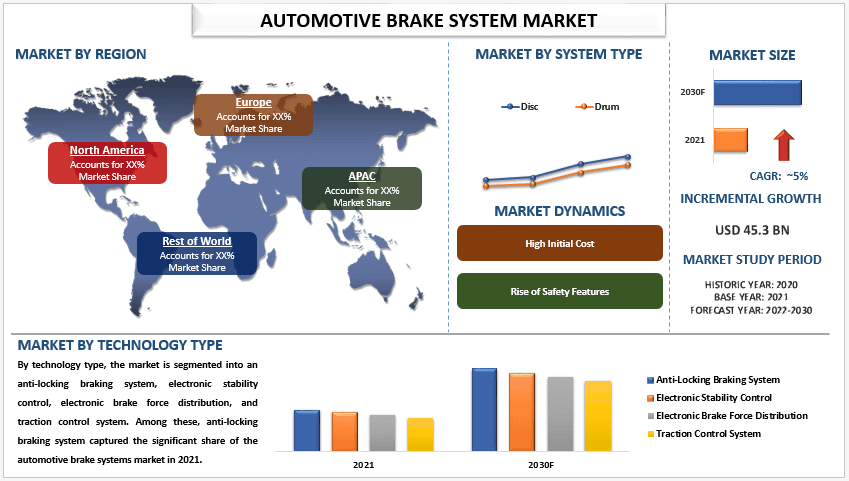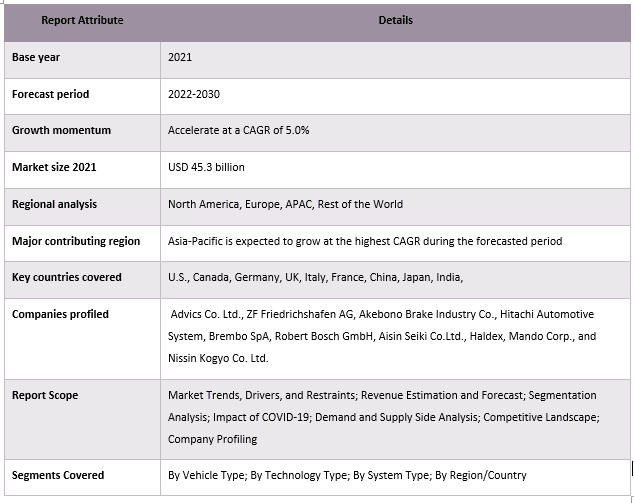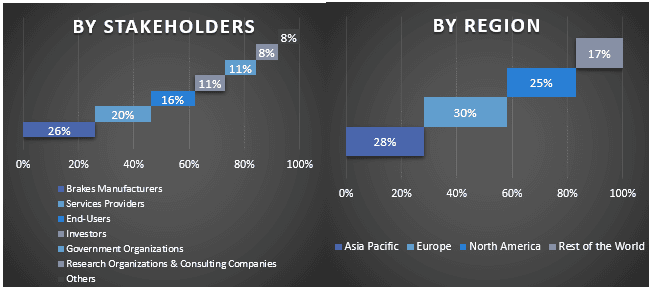自動車ブレーキシステム市場:現状分析と予測(2022年~2030年)
システムタイプ(ディスクおよびドラム); 車両タイプ(コンパクト乗用車、ミッドサイズ乗用車、プレミアム乗用車、ラグジュアリー乗用車、軽商用車、および大型商用車)と技術タイプ(アンチロック・ブレーキング・システム、エレクトロニック・スタビリティ・コントロール、エレクトロニック・ブレーキ・フォース・ディストリビューション、およびトラクション・コントロール)、および地域/国に重点を置く

自動車ブレーキシステム市場は、2021年に453億米ドルと評価され、2022年から2030年までCAGR 5.0%で成長すると予想されています。世界的に車両の生産が増加しており、それに伴い自動車ブレーキシステムの需要が高まっているためです。自動車産業は急速な技術革新を遂げており、これにより、新しく高度なブレーキシステムが開発されています。これらのシステムは、性能の向上、安全性の向上、環境負荷の低減を実現します。例えば、ブレーキシステムの開発と製造におけるグローバルリーダーであるブレンボは、2022年10月19日にBrembo Venturesを立ち上げました。このベンチャーキャピタルユニットは、明日のモビリティのための革新的なソリューションの開発を加速することを目的としています。
市場で活動している主要なプレーヤーには、Advics Co. Ltd.、ZF Friedrichshafen AG、曙ブレーキ工業株式会社、日立オートモティブシステムズ、Brembo SpA、Robert Bosch GmbH、Aisin Seiki Co.Ltd.、Haldex、Mando Corp.、Nissin Kogyo Co. Ltd.などがあります。これらのプレーヤーは、ハイテクで革新的な製品/技術を顧客に提供するために、いくつかのM&Aとパートナーシップを実施しています。
レポートで提示される洞察
「システムタイプ別では、ディスクセグメントが2021年に市場の大幅な成長を遂げるでしょう。」
システムタイプに基づいて、市場はディスクとドラムにセグメント化されています。これらのうち、スマート家電セグメントが2021年に市場を支配しました。これは、ディスクブレーキが従来のドラムブレーキと比較して、ブレーキ性能が向上しているためです。ディスクブレーキは、より優れた制動力、より短い停止距離、およびより優れたブレーキフィーリングを提供します。これが、自動車ブレーキシステム市場におけるディスクセグメントの成長に貢献しています。
「技術タイプ別では、トラクションコントロールシステムが2021年に市場の大幅な成長を遂げるでしょう。」
技術タイプ別に、市場はアンチロックブレーキシステム、電子安定制御、電子ブレーキ力配分、およびトラクションコントロールシステムにセグメント化されています。これらのうち、トラクションコントロールシステム技術は、2021年に自動車ブレーキシステム市場で大幅な成長率を遂げるでしょう。ワイヤレス自動車ブレーキシステム技術の主なシェアは、ホイールの回転を防ぎ、横滑りや制御不能のリスクを軽減することにより、車両の安定性を向上させる能力に起因すると考えられます。これは、滑りやすい道路や雨天などの悪条件での運転において特に重要です。
「アジア太平洋地域は、2021年に自動車ブレーキシステム市場で大幅な成長率を遂げるでしょう。」
アジア太平洋地域は、自動車生産の増加、中間層の成長、および技術の進歩により、自動車ブレーキシステム市場で大幅な成長が見込まれています。さらに、厳しい安全規制により、これらの規制を満たす高度なブレーキシステムの需要が、この地域の市場の成長を牽引すると予想されます。アジア太平洋地域の大手自動車ブレーキシステムメーカーは、市場の成長に貢献すると予想される、新しい高度なブレーキシステムを導入するために、研究開発に投資しています。全体として、アジア太平洋地域の自動車ブレーキシステム市場は、今後数年間で大幅な成長が見込まれています。
自動車ブレーキシステム市場レポートの範囲

このレポートを購入する理由:
- この調査には、認証された主要な業界専門家によって検証された、市場規模の算定と予測分析が含まれています。
- このレポートは、業界全体のパフォーマンスの概要を一目で確認できます。
- このレポートは、主要なビジネス財務、製品ポートフォリオ、拡張戦略、および最近の開発に重点を置いて、主要な業界ピアの詳細な分析をカバーしています。
- 業界に存在するドライバー、制約、主要なトレンド、および機会の詳細な調査。
- この調査は、さまざまなセグメントにわたる市場を包括的にカバーしています。
- 業界の地域レベルの詳細な分析。
カスタマイズオプション:
グローバル自動車ブレーキシステム市場は、要件またはその他の市場セグメントに応じてさらにカスタマイズできます。これに加えて、UMIは、お客様が独自のビジネスニーズをお持ちであることを理解しているため、お客様の要件に完全に適合するレポートを入手するためにお気軽にお問い合わせください。
目次
自動車ブレーキシステム市場分析(2022年~2030年)の調査方法
グローバル自動車ブレーキシステム市場の過去の市場分析、現在の市場規模の推定、および将来の市場予測は、世界の主要地域における自動車ブレーキシステムの採用状況を作成および分析するために行われた3つの主要なステップでした。過去の市場数値を収集し、現在の市場規模を推定するために、徹底的な二次調査が実施されました。次に、これらの洞察を検証するために、多数の調査結果と仮定が考慮されました。さらに、グローバル自動車ブレーキシステム市場のバリューチェーン全体にわたる業界の専門家との徹底的な一次インタビューも実施されました。一次インタビューを通じて市場数値を仮定および検証した後、トップダウン/ボトムアップアプローチを採用して、市場全体の規模を予測しました。その後、市場の内訳とデータ三角測量法を採用して、業界のセグメントおよびサブセグメントの市場規模を推定および分析しました。詳細な方法論を以下に説明します。
過去の市場規模の分析
ステップ1:二次情報源の詳細な調査:
年次報告書と財務諸表、業績発表、プレスリリースなどの企業内部情報源、およびジャーナル、ニュースと記事、政府刊行物、競合他社の刊行物、セクターレポート、サードパーティデータベース、その他の信頼できる刊行物を含む外部情報源を通じて、自動車ブレーキシステム市場の過去の市場規模を取得するために、詳細な二次調査を実施しました。
ステップ2:市場セグメンテーション:
自動車ブレーキシステム市場の過去の市場規模を取得した後、詳細な二次分析を実施して、主要地域のさまざまなセグメントとサブセグメントに関する過去の市場の洞察とシェアを収集しました。主要なセグメントは、製品、技術、エンドユーザーとしてレポートに含まれています。さらに、国レベルの分析を実施して、その地域におけるテストモデルの全体的な採用を評価しました。
ステップ3:要因分析:
さまざまなセグメントおよびサブセグメントの過去の市場規模を取得した後、詳細な要因分析を実施して、自動車ブレーキシステム市場の現在の市場規模を推定しました。さらに、自動車ブレーキシステム市場の製品、技術、およびエンドユーザーなどの従属変数と独立変数を使用して要因分析を実施しました。世界中の自動車ブレーキシステム市場セクターにおけるトップパートナーシップ、合併と買収、事業拡大、および製品の発売を考慮して、需要と供給側のシナリオについて徹底的な分析を実施しました。
現在の市場規模の推定と予測
現在の市場規模の算定:上記の3つのステップからの実用的な洞察に基づいて、グローバル自動車ブレーキシステム市場の現在の市場規模、主要なプレーヤー、およびセグメントの市場シェアに到達しました。必要な割合のシェア分割と市場の内訳はすべて、上記の二次的アプローチを使用して決定され、一次インタビューを通じて検証されました。
推定と予測:市場の推定と予測については、利害関係者が利用できる推進要因とトレンド、制約、および機会を含むさまざまな要因に重みが割り当てられました。これらの要因を分析した後、関連する予測手法、つまり、トップダウン/ボトムアップアプローチを適用して、グローバル全体の主要市場におけるさまざまなセグメントおよびサブセグメントの2028年の市場予測に到達しました。市場規模の推定に採用された調査方法には、以下が含まれます。
- 収益(米ドル)の観点からの業界の市場規模、および国内の主要市場における自動車ブレーキシステム市場の採用率
- 市場セグメントおよびサブセグメントのすべての割合シェア、分割、および内訳
- 提供される製品の観点から見たグローバル自動車ブレーキシステム市場の主要なプレーヤー。また、急速に成長している市場で競争するためにこれらのプレーヤーが採用した成長戦略
市場規模とシェアの検証
一次調査:主要地域全体のトップレベルのエグゼクティブ(CXO/VP、営業部長、マーケティング部長、オペレーション部長、地域部長、カントリー部長など)を含む主要オピニオンリーダー(KOL)との詳細なインタビューを実施しました。次に、一次調査の結果を要約し、述べられた仮説を証明するために統計分析を実施しました。一次調査からのインプットは二次調査の結果と統合され、情報が実用的な洞察に変わりました。
さまざまな地域における主要参加者の分割

市場エンジニアリング
データ三角測量法を採用して、市場全体の推定を完了し、グローバル自動車ブレーキシステム市場の各セグメントおよびサブセグメントの正確な統計数値を導き出しました。データは、グローバル自動車ブレーキシステム市場の製品、技術、およびエンドユーザーの分野におけるさまざまなパラメーターとトレンドを調査した後、いくつかのセグメントとサブセグメントに分割されました。
グローバル自動車ブレーキシステム市場調査の主な目的
グローバル自動車ブレーキシステム市場の現在および将来の市場動向は、調査で正確に特定されました。投資家は、調査で実施された定性的および定量的な分析に基づいて、投資の裁量に基づいて戦略的な洞察を得ることができます。現在および将来の市場動向は、地域レベルでの市場の全体的な魅力を決定し、産業参加者が未開発の市場を活用してファーストムーバーの優位性から利益を得るためのプラットフォームを提供しました。調査のその他の定量的な目標には、以下が含まれます。
- 価値(米ドル)の観点から、自動車ブレーキシステム市場の現在および予測の市場規模を分析します。また、さまざまなセグメントおよびサブセグメントの現在および予測の市場規模を分析します
- 調査のセグメントには、車種、技術タイプ、およびシステムタイプが含まれます。
- 自動車ブレーキシステム業界の規制の枠組みを定義し、分析します
- さまざまな仲介業者の存在に関連するバリューチェーンを分析し、業界の顧客と競合他社の行動を分析します
- 主要地域における自動車ブレーキシステム市場の現在および予測の市場規模を分析します
- レポートで調査された地域の主要国には、アジア太平洋、ヨーロッパ、北米、およびその他の地域が含まれます
- 自動車ブレーキシステム市場の企業プロファイル、および急速に成長している市場で持続するために市場プレーヤーが採用した成長戦略
- 業界の詳細な地域レベルの分析
関連 レポート
この商品を購入したお客様はこれも購入しました










